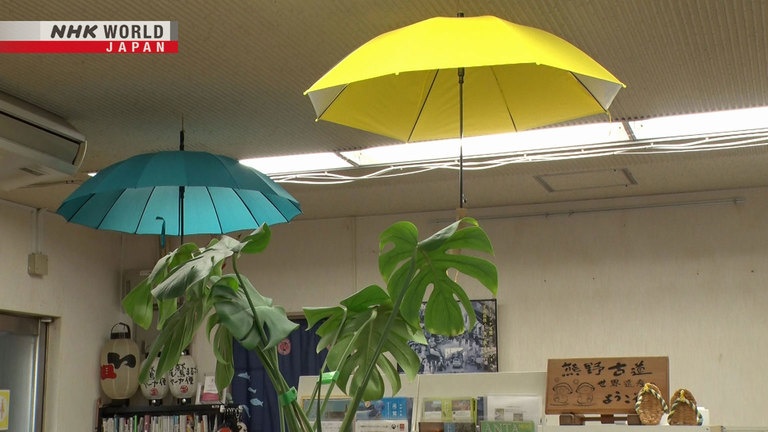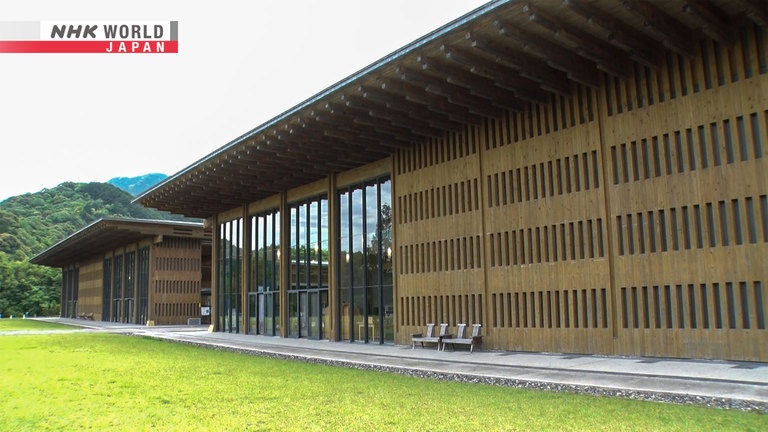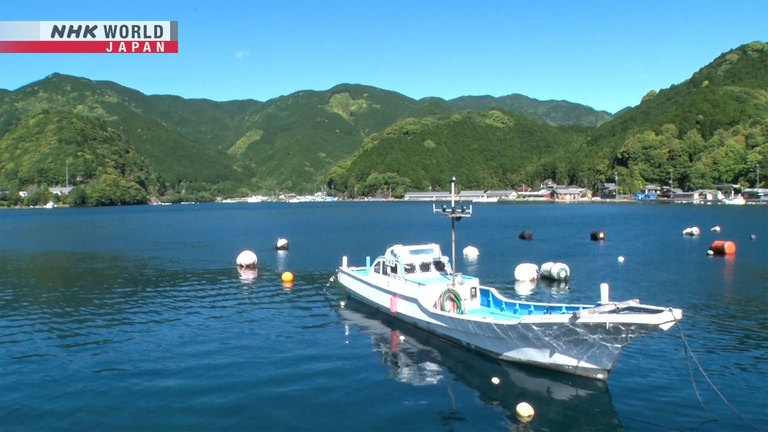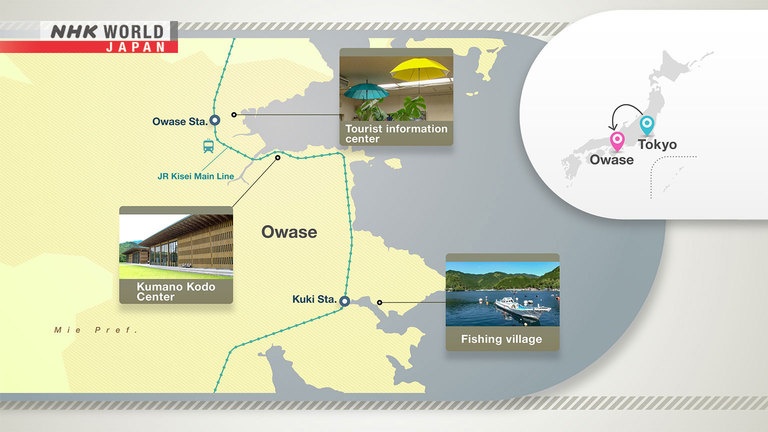Owase: City of Abundant Rain
The city of Owase, in Mie Prefecture, is known as one of the rainiest places in Japan and the people living there have developed their own culture and customs relating to this distinct climate. Stephen Carter comes from New Mexico, an area of southwest USA that is known for its desert climate. On this episode of Journeys in Japan, he visits Owase to experience firsthand how the city has coped with the intense precipitation. On a section of the ancient Kumano Kodo pilgrimage trail, he observes how it was laid out to withstand the torrential downpours. And in a small fishing village, he discovers how the rain and the mountains create fertile fishing grounds. He also takes a cruise along the coast to view a remarkable rock formation.
Owase Tourism and Products Association

In keeping with Owase's reputation as a "City of Rain," this facility holds workshops and classes related to the rain, such as umbrella making.
Kumano Kodo Center

This is a visitor center for the Kumano Kodo pilgrimage route which was designated as a World Heritage Site in 2004.
Kuki Town

Near this scenic fishing town, visitors can take a boat ride to visit the Ohai coastline, which is known for its spectacular rock formation.
Access

To reach Owase from Tokyo, you take the Shinkansen bullet train to Nagoya, then transfer to a local train or express bus. In all, the journey takes about five hours.
Transcript
"Journeys in Japan"
Many areas of Japan are blessed with an abundance of water.
Rain is often seen as a gift from the heavens.
The area around Owase gets some of the largest rainfall in the whole country.
Stephen Carter is from the United States.
He's lived in Japan for close on 40 years.
A resident of Nagoya, Stephen works as a translator,
while also helping as a volunteer guide in his neighborhood.
I was born and lived in the American Southwest, desert country,
where not a lot of rain falls.
I was really excited to know that
Owase is a place where they have lots of rain.
I'm really eager to check it out.
Yoo-hoo!
On this edition of "Journeys in Japan,"
Stephen travels to the tranquil community of Owase,
to explore the mountains and the coast,
and to meet the people who call it home.
Owase, City of Abundant Rain
Owase City is located about 370 kilometers west of Tokyo,
on the coast of Mie Prefecture.
It lies just to the north of the sacred area of Kumano.
It has a population of about 16,000,
and many people there work in forestry or the fishing industry.
Each year, about 4,000 millimeters of rain falls on Owase.
That's twice as much as in Tokyo,
making it one of the rainiest places in Japan.
Well, it looks like it's stopped raining.
(Owase Tourist Association)
I'm in the tourist information center.
And there are a lot of umbrellas here.
Why do you have umbrellas hanging here?
Owase is known as the "Town of Rain." These umbrellas symbolize that.
I see. Do you get a lot of rainfall?
It really rains here.
How much?
We get big raindrops that splash up as they hit the ground.
It feels like it's raining from underneath, like when a bucket is overturned.
This is an Owase umbrella.
It has more ribs than usual, and the fabric is stronger.
Local craftsman used to make them to withstand the heavy rain in Owase.
It's actually quite light.
It seems to be strong and sturdy.
Where I grew up, we got very little rain.
I don't remember using an umbrella as a child.
In Owase, all children are given umbrellas when they enter elementary school.
So, why does Owase get so much precipitation?
Futamura Naoji is a former science teacher,
and he's been studying the climate of this area for 50 years.
Warm, humid air blows in from the sea and,
behind the town, hills rise to 500 meters.
And there are mountains behind the hills,
rising as high as 1,000 or 1,500 meters.
The winds tend to blow from the southeast, from the east or the northeast.
As the air currents rise, they produce cloud.
This is the mechanism that brings the rain.
There is one place in Owase
that takes advantage of the area's reputation as a "Town of Rain."
Please choose the fabric you like.
I'll have this one.
Next, please pick a handle.
There are many kinds. Just choose one you like.
It's a workshop where you can try your hand
at making your own personalized umbrella.
You can adjust the handle any way you like.
That should be enough. It's very nice.
I don't remember ever using an umbrella back home
but here I am making one.
This is kind of hard to do.
The wood is so hard. It's also slippery.
I think I'll stop here.
Ta-da! It's done. My very own umbrella.
Do you know what this is?
I've seen them before.
This is a "teruteru bozu."
It's the tradition in Japan
to hang them under the eaves of the house to pray for fine weather.
That's cute. Do people still make these?
We used to make them in elementary school.
We would hang them under the eaves
if the weather was bad before an excursion.
- There's a song that goes with them, too.
- Really?
Rain plays an important role in Owase's most important industry, forestry.
"Hinoki," or cypress wood grows particularly well in this area.
Owase cypress is renowned for its quality.
This lumber is Owase cypress. It's our local specialty.
What do the numbers mean?
These numbers indicate the diameter. This one is 34 centimeters across.
I'd say it's about 80 years old. Try sniffing the wood.
This hinoki has this delicate foresty smell.
It smells like Japanese houses.
The lumber is highly rated as a building material.
The growth rings are close together. That means the wood is strong.
The reddish core also sets it apart.
Because this wood is sturdy,
it can be used for making the pillars that support houses.
This wood seems really solid and dense.
I'm no expert but I think it'll make really great building material.
I wonder how it grows.
It's started raining.
The rain is also an important factor that makes Owase cypress special.
Wow. We're really deep in the woods.
Come this way.
The city operates its own municipal forest,
which it calls "Minna no Mori," "Everyone's Woodland."
The aim is to promote Owase's primary industry,
but also to give people a place to learn about nature.
Walking here is quite easy.
The straw on the ground makes it easier.
These trees are all Owase cypress.
This one is about 30 years old.
Owase is warm year-round and has high rainfall.
So the trees continue to grow in the autumn, too.
But even as they grow higher their trunks don't get much thicker.
That's because we use a technique to make sure they grow up strong.
The quality of Owase cypress is thanks to the topography here
and the abundant rainfall.
Normally, 3,000 trees are planted per hectare.
But in Owase, we plant 6,000 per hectare.
Also, because the slopes are steep,
the rainfall leaches out the nutrients, leaving poor soil.
Here, we plant more and then thin them out.
We market the ones that survive this competition.
It's our way of producing better lumber.
Because the trees develop slowly
due to the steep slopes and the nutrient-deficient soil,
their wood grows into strong, hard lumber that is considered first-rate.
Hey, little guy. Be sure to grow up big and strong.
Owase cypress is not just used as a construction material.
Hello.
Hello.
Is this "wappa"?
I've heard about it, but this is the first time I've seen it.
The wood is used to make the local style of lacquerware,
known as Owase wappa.
Feel free to pick them up.
If it's OK... This one is very light.
The wood is Owase cypress. Once it's dried out, it's light and durable.
What's this?
Since the Edo Period,
the foresters here have used these as "bento" (lunch boxes).
These boxes are good for carrying food,
because they keep it from spoiling.
Is that because they're made from cypress?
Yes.
Lacquer also has antibacterial properties,
so it's doubly effective in keeping food fresh.
Seko Koshi is a craftsman who is keeping alive the tradition of Owase wappa.
From forming the boxes to painting on the lacquer,
there are 45 separate processes.
Seko does everything himself.
What are you doing now?
I will bind it together, using cherry bark.
The bark?
Yes, the bark of the tree.
That's unusual.
Cherry has the strongest bark.
We don't use adhesives to bind the wood.
It's very precise work.
It's really precise work, fashioned with great skill, great precision.
It's beautiful.
Is there a special knack for doing this?
You just need experience.
This building was constructed using the local timber.
More than 6,000 of the Owase cypress trees were used to build it.
The fragrance of the wood is wonderful.
The building is very spacious, very durable. It's very beautiful.
Do you know what this is?
I can see the word UNESCO.
This is our World Heritage Site certification.
It's a visitor center for the Kumano Kodo,
a network of ancient pilgrimage trails in this region,
which was designated a World Heritage Site in 2004.
Owase is a point on the pilgrimage route that leads to Kumano,
an area considered very sacred, as an abode of the Shinto deities.
This stretch of the Kumano Kodo trail leads to a pass known as Magose-toge.
It's covered with large paving stones all the way to the top.
This trail leads over the Magose-toge Pass.
This section of the trail is about 2.2 km long.
Going up to the pass it's 1.3 km, and another 900 m down the other side.
There's a technique for walking along this trail.
Keep an eye out for bumps and indentations.
And it's best to take small steps, placing your feet carefully on each stone.
That way you won't slip or get tired. Walk slowly and enjoy the trail.
If you stop and look up,
you can see the trees reaching up to the sky.
It's a beautiful sight.
Really beautiful.
The paving stones contrast with the trees.
This place has this mysterious beauty about it.
It's almost mystical.
Let's stop here a while and listen to the stream.
Breathe deeply and inhale the negative ions.
Take a look at this ditch. Do you know what it's for?
It looks like a gutter.
Exactly. When there's heavy rain,
the water flows down from small streams further up.
The ditches are laid out to channel the water across the trail,
away from the paving stone.
When the rain is torrential,
there's too much water to channel into these small ditches.
In a downpour, this turns into a waterfall.
The road itself acts as the gutter.
It channels away the water quickly,
reducing its impact and protecting the trail.
Amazing.
Since the old days, the people in this area
have developed the wisdom to protect their sacred route.
Yoo-hoo!
Hello!
It was a long hard walk but this is a really pretty view.
Oh, yikes, this feels great.
After all that walking, this is so relaxing.
Paradise.
This bath water here is actually seawater
that's been pumped up from the deep off the coast.
It is rich in minerals, as the bay is fed by water
that has been carried down from the mountains of Owase.
By car, the Kuki district is about 20 minutes from Owase's center.
I've come to this tiny fishing village.
The air is very clean, surrounded by green.
The water is super clear. It's just a very, peaceful spot.
This is a friendly-looking place. Let's check it out.
There's a map of Kuki.
This visitor information center is actually run by a local resident.
Is this your place?
Yes, it's a private visitor center.
Kachi Keiko moved to Kuki four years ago.
What brought you here?
I love being so close to nature here, both the sea and the mountains.
The sea is wonderful, but the mountains are amazing,
with giant trees and virgin forest.
So that's why you call your place a "mountain hut" even though it's by the sea?
This little lane feels very residential.
You can really tell this is where the people of the village live their lives.
Hello.
Hello.
This place is like a maze. Let's go this way.
Oh man, so many stairs.
It's such a peaceful place.
It's so quiet and relaxed.
This looks like a restaurant. I'm going to check it out.
This restaurant serves freshly caught local seafood
which you can grill for yourself over charcoal.
Wow, I wonder what kind of fish this is.
What's this fish?
This is "kowata" - sunfish intestines.
I've never eaten this before.
We catch sunfish in the sea off Kuki.
And we dry the meat overnight.
Let's try it.
It's crunchy.
It has a good texture, doesn't it?
Flavor is delicate, firm texture.
I like it.
Thanks to the pristine water,
there is seafood to be caught literally in front of the restaurant.
It's a damselfish.
Let's grill this. I just caught it.
Great! Well done!
It's really fresh. Super fresh!
Why do the fish in Owase taste so good?
It's because the mountains are so close.
The nutrients flow down into the sea and create a fertile fishing ground.
The coastline here boasts some remarkable geology.
This is the first time I've been on a boat in many years.
I'm really looking forward to the experience.
This is going to be fun.
Stephen is being taken out to a rocky section known as Ohai.
We've arrived. This is Ohai. I'll take the boat in.
(Ohai)
These huge vertical cliffs of rock.
It's just amazing, I've never been to a place like this before.
Really beautiful.
I've been in Japan for many, many years.
I never knew a place like this existed in Japan.
Owase is truly a beautiful place.
I've come to a place that's very different from my desert hometown.
They get a lot of rain here
and the people make the rain a part of their daily lives.
Their economy also depends on it
for the special hinoki lumber they produce.
I managed to walk the Kumano Kodo World Heritage Site.
It was very arduous but it was a terrific experience
and I'm very glad I did it.
I also got to eat a lot of seafood which I never did growing up.
I really hope to come back.
To reach Owase from Tokyo,
you take the Shinkansen bullet train to Nagoya.
Then, transfer to a local train or express bus.
In all, the journey takes about five hours.